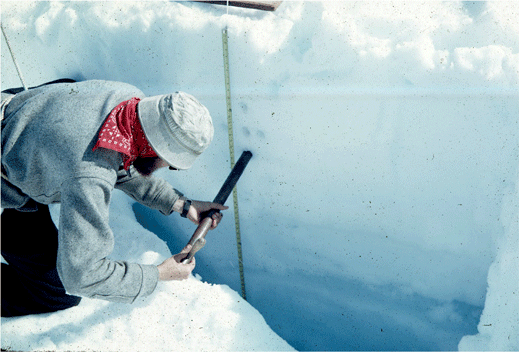|
Ice Core
An ice core is a core sample that is typically removed from an ice sheet or a high mountain glacier. Since the ice forms from the incremental buildup of annual layers of snow, lower layers are older than upper ones, and an ice core contains ice formed over a range of years. Cores are drilled with hand augers (for shallow holes) or powered drills; they can reach depths of over two miles (3.2 km), and contain ice up to 800,000 years old. The physical properties of the ice and of material trapped in it can be used to reconstruct the climate over the age range of the core. The proportions of different oxygen and hydrogen isotopes provide information about ancient temperatures, and the air trapped in tiny bubbles can be analysed to determine the level of atmospheric gases such as carbon dioxide. Since heat flow in a large ice sheet is very slow, the borehole temperature is another indicator of temperature in the past. These data can be combined to find the climate model ... [...More Info...] [...Related Items...] OR: [Wikipedia] [Google] [Baidu] |
Greenland Ice Sheet Project
The Greenland Ice Sheet Project (GISP) was a decade-long project to drill ice cores in Greenland that involved scientists and funding agencies from Denmark, Switzerland and the United States. Besides the U.S. National Science Foundation (NSF), funding was provided by the Swiss National Science Foundation and the Danish Commission for Scientific Research in Greenland. The ice cores provide a proxy archive of temperature and atmospheric constituents that help to understand past climate variations. The preliminary GISP field work started in 1971 at Dye 3 (), where a 372 meter deep, 10.2 cm diameter core was recovered. After this, annual field expeditions were carried out to drill intermediate depth cores at various locations on the ice sheet. The first was a 398 m core at Milcent and another was a 405 m core at the Crete station in 1974. After working out various logistical and engineering problems related to the development of a more sophisticated drilling rig, drilling to bed ... [...More Info...] [...Related Items...] OR: [Wikipedia] [Google] [Baidu] |
Byrd Station
The Byrd Station is a former research station established by the United States during the International Geophysical Year by U.S. Navy Seabees during Operation Deep Freeze II in West Antarctica. History A joint Army, Navy, Air Force, and Marines operation supported an overland tractor train traverse that left out of Little America V in late 1956 to establish the station. The train was led by Army Major Merle Dawson and completed a traverse of over unexplored country in Marie Byrd Land to blaze a trail to a spot selected beforehand. The station consisted of a set of four prefabricated buildings and was erected in less than one month by U.S. Navy Seabees. It was commissioned on January 1, 1957. The original station ("Old Byrd") lasted about four years before it began to collapse under the snow. Construction of a second underground station in a nearby location began in 1960, and it was used until 1972. The Operation Deep Freeze activities were succeeded by "Operation Deep Freez ... [...More Info...] [...Related Items...] OR: [Wikipedia] [Google] [Baidu] |
Clathrate
A clathrate is a chemical substance consisting of a lattice that traps or contains molecules. The word ''clathrate'' is derived from the Latin (), meaning ‘with bars, latticed’. Most clathrate compounds are polymeric and completely envelop the guest molecule, but in modern usage clathrates also include host–guest complexes and inclusion compounds.Atwood, J. L. (2012) "Inclusion Compounds" in ''Ullmann's Encyclopedia of Industrial Chemistry''. Wiley-VCH, Weinheim. According to IUPAC, clathrates are inclusion compounds "in which the guest molecule is in a cage formed by the host molecule or by a lattice of host molecules." The term refers to many molecular hosts, including calixarenes and cyclodextrins and even some inorganic polymers such as zeolites. Clathrates can be divided into two categories: clathrate hydrates and inorganic clathrates. Each clathrate is made up of a framework and guests that reside the framework. Most common clathrate crystal structures can be compos ... [...More Info...] [...Related Items...] OR: [Wikipedia] [Google] [Baidu] |
Crystal Structure
In crystallography, crystal structure is a description of the ordered arrangement of atoms, ions or molecules in a crystal, crystalline material. Ordered structures occur from the intrinsic nature of the constituent particles to form symmetric patterns that repeat along the principal directions of Three-dimensional space (mathematics), three-dimensional space in matter. The smallest group of particles in the material that constitutes this repeating pattern is the unit cell of the structure. The unit cell completely reflects the symmetry and structure of the entire crystal, which is built up by repetitive Translation (geometry), translation of the unit cell along its principal axes. The translation vectors define the nodes of the Bravais lattice. The lengths of the principal axes, or edges, of the unit cell and the angles between them are the lattice constants, also called ''lattice parameters'' or ''cell parameters''. The symmetry properties of the crystal are described by the con ... [...More Info...] [...Related Items...] OR: [Wikipedia] [Google] [Baidu] |
Dome C
Dome C, also known as Dome Circe, Dome Charlie or Dome Concordia, located at Antarctica at an elevation of above sea level, is one of several summits or "domes" of the Antarctic Ice Sheet. Dome C is located on the Antarctic Plateau, inland from the French research station at Dumont D'Urville, inland from the Australian Casey Station and inland from the Italian Zucchelli station at Terra Nova Bay. Russia's Vostok Station is away. Dome C is the site of the Concordia Research Station, jointly operated by France and Italy. History In the 1970s, Dome C was the site of ice core drilling by field teams of several nations. It was called Dome Charlie (NATO Phonetic Alphabet code for the letter ''C'') by the U.S. Naval Support Force, Antarctica, and its Squadron VXE-6, which provided logistical support to the field teams. In January and November 1975, three LC-130 Hercules aircraft suffered severe damage during attempted takeoffs from Dome Charlie. In November 1975 and November ... [...More Info...] [...Related Items...] OR: [Wikipedia] [Google] [Baidu] |
Summit Camp
Summit Camp, also Summit Station, is a year-round staffed research station near the apex of the Greenland ice sheet. The station is located at above sea level. The population of the station is typically five in wintertime and reaches a maximum of 38 in the summer. The station is operated by the United States National Science FoundationArctic Logistics Information And Support (ALIAS) through the logistical-support contractor Battelle Arctic Research Operations (Battelle ARO). A permit from the Danish Polar Center ( da, Dansk Polarcenter) under the auspices of the Home R ... [...More Info...] [...Related Items...] OR: [Wikipedia] [Google] [Baidu] |
Firn
__NOTOC__ Firn (; from Swiss German "last year's", cognate with ''before'') is partially compacted névé, a type of snow that has been left over from past seasons and has been recrystallized into a substance denser than névé. It is ice that is at an intermediate stage between snow and glacial ice. Firn has the appearance of wet sugar, but has a hardness that makes it extremely resistant to shovelling. Its density generally ranges from 0.35 g/cm3 to 0.9 g/cm3, and it can often be found underneath the snow that accumulates at the head of a glacier. Snowflakes are compressed under the weight of the overlying snowpack. Individual crystals near the melting point are semiliquid and slick, allowing them to glide along other crystal planes and to fill in the spaces between them, increasing the ice's density. Where the crystals touch they bond together, squeezing the air between them to the surface or into bubbles. In the summer months, the crystal metamorphosis can occur ... [...More Info...] [...Related Items...] OR: [Wikipedia] [Google] [Baidu] |
Taku Glacier Firn Ice Sampling
Taku may refer to: Places North America * the Taku River, in Alaska and British Columbia ** Fort Taku, also known as Fort Durham and as Taku, a former fort of the Hudson's Bay Company near the mouth of the Taku River ** the Taku Glacier, in Alaska near Juneau ** Taku Towers, in Alaska, near Juneau ** Taku Harbor, in Alaska, near Juneau ** Taku Inlet, in Alaska ** the Taku Plateau, in British Columbia * Taku Arm of Tagish Lake in British Columbia ** Taku, British Columbia, a locality on Tagish Lake Asia * Taku Forts, forts on the south bank of the Hai He, in Tanggu District, Tianjin municipality, in northeastern China * Taku, Saga, a city in Saga prefecture on the island of Kyūshū, Japan * Taku, India, a town in India Oceania * Taku, Kiribati, a village in Kiribati. Peoples * The Taku people, an Alaska Native group, who are a ''kwaan'' or tribe of the Tlingit *Taku River Tlingit First Nation, government in British Columbia People Surname * Moses Taku, a rabbi, 13th ... [...More Info...] [...Related Items...] OR: [Wikipedia] [Google] [Baidu] |
East Greenland Ice-Core Project
The East Greenland Ice-Core Project, known as EGRIP, is a scientific project that plans to retrieve an ice core from the Northeast Greenland ice stream. The first season in the field was 2015; the project was expected to be drilling through to the base of the ice sheet by 2020. Much of the camp set up for the North Greenland Eemian Ice Drilling Project (NEEM) was moved to the EGRIP location in 2015. The equipment was towed by several tractors. The team ran low on fuel and had to abandon some equipment, arriving at the EGRIP location on 26 May, after nine days of towing. In March 2020, the 2020 EGRIP field campaign was cancelled due to the ongoing COVID-19 pandemic The COVID-19 pandemic, also known as the coronavirus pandemic, is an ongoing global pandemic of coronavirus disease 2019 (COVID-19) caused by severe acute respiratory syndrome coronavirus 2 (SARS-CoV-2). The novel virus was first identif .... The 2021 field season was also cancelled. EastGRIP reopened for ... [...More Info...] [...Related Items...] OR: [Wikipedia] [Google] [Baidu] |
ITASE
{{short description, Scientific research platform The International Trans-Antarctic Scientific Expedition (ITASE) was created in 1990 with the purpose of studying climate change through research conducted in Antarctica. Antarctica was chosen as the optimal site to study the atmosphere because of its remote location and relatively undisturbed environment. Research in many fields has been conducted in Antarctica through ITASE, including astronomy, atmospheric sciences, biology, earth sciences, environmental science, geology, glaciology, marine biology, oceanography, and geophysics. History A 1990 meeting held in Grenoble, France, served as a site of discussion regarding national ice coring efforts and the possibility of international collaboration between the world's top scientists. As a result, nineteen nations worldwide, including Australia, Brazil, Canada, China, France, Germany, Italy, Japan, Norway, Russia, Sweden, Switzerland, the U.K. and the United States, teamed up to s ... [...More Info...] [...Related Items...] OR: [Wikipedia] [Google] [Baidu] |
British Antarctic Survey
The British Antarctic Survey (BAS) is the United Kingdom's national polar research institute. It has a dual purpose, to conduct polar science, enabling better understanding of global issues, and to provide an active presence in the Antarctic on behalf of the UK. It is part of the Natural Environment Research Council (NERC). With over 400 staff, BAS takes an active role in Antarctic affairs, operating five research stations, one ship and five aircraft in both polar regions, as well as addressing key global and regional issues. This involves joint research projects with over 40 UK universities and more than 120 national and international collaborations. Having taken shape from activities during World War II, it was known as the Falkland Islands Dependencies Survey until 1962. History Operation Tabarin was a small British expedition in 1943 to establish permanently occupied bases in the Antarctic. It was a joint undertaking by the Admiralty and the Colonial Office. At the end of t ... [...More Info...] [...Related Items...] OR: [Wikipedia] [Google] [Baidu] |





.jpg)